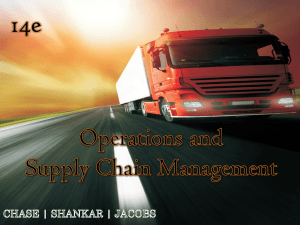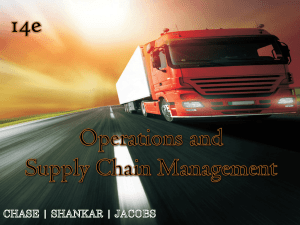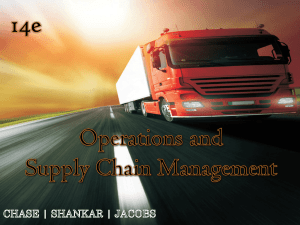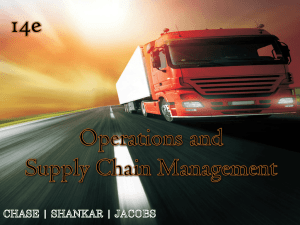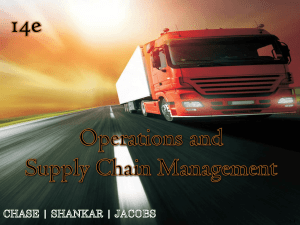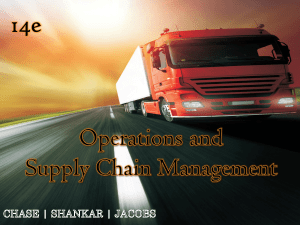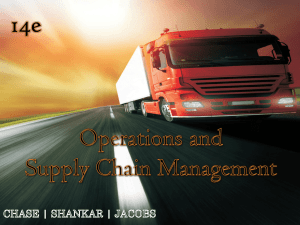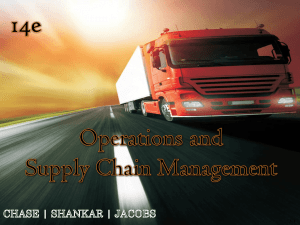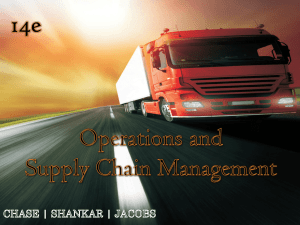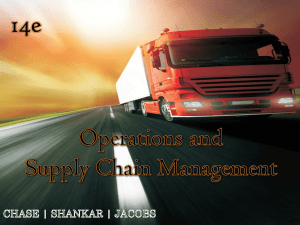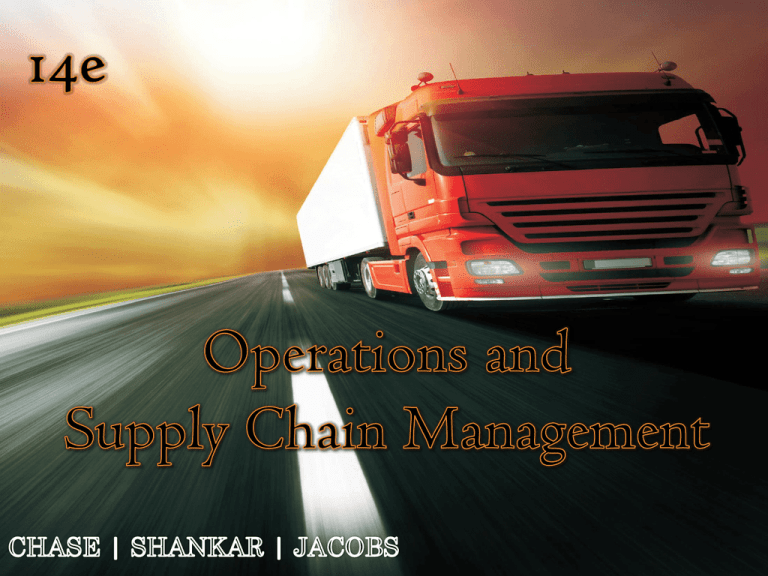
23–1
Chapter Twenty-Three
McGraw-Hill/Irwin
Copyright © 2014 by The McGraw-Hill Companies, Inc. All rights reserved.
23–2
• LO23–2: Analyze bottleneck resources and
apply TOC principles to controlling a process.
• LO23–3: Compare TOC to conventional
approaches.
Copyright © 2014 by McGraw Hill Education (India) Private Limited. All rights reserved.
• LO23–1: Explain the Theory of Constraints
(TOC).
• LO23–4: Evaluate bottleneck scheduling
problems by applying TOC principles.
23–3
Copyright © 2014 by McGraw Hill Education (India) Private Limited. All rights reserved.
• Do not balance capacity, balance the flow.
• The level utilization of a non-bottleneck
resource is not determined by its own potential
but by some other constraint in the system.
• Utilization and activation of a resource are not
the same.
• An hour lost at a bottleneck is an hour lost for
the entire system.
• An hour saved at a non-bottleneck is a mirage.
23–4
Copyright © 2014 by McGraw Hill Education (India) Private Limited. All rights reserved.
• Bottlenecks govern both throughput and
inventory in the system.
• Transfer batch may not, and many times
should not, be equal to the process batch.
• A process batch should be variable both
along its route and in time.
• Priorities can be set only by examining the
system’s constraints, and lead time is a
derivative of the schedule.
23–5
• Decide how to exploit the system constraints.
• Subordinate everything else to that decision.
• Elevate the system constraints.
• If, in the previous steps, the constraints have
been broken, go back to step 1, but do not let
inertia become the system constraint.
Copyright © 2014 by McGraw Hill Education (India) Private Limited. All rights reserved.
• Identify the system constraints.
23–6
Copyright © 2014 by McGraw Hill Education (India) Private Limited. All rights reserved.
• The goal of a firm is to make
money.
23–7
– An absolute measurement in dollars
• Return on investment
– A relative measure based on investment
Copyright © 2014 by McGraw Hill Education (India) Private Limited. All rights reserved.
• Net profit
• Cash flow
– A survival measurement
23–8
– The rate at which money is generated by the
system through sales
• Inventory
– All the money that the system has invested in
purchasing things it intends to sell
Copyright © 2014 by McGraw Hill Education (India) Private Limited. All rights reserved.
• Throughput
• Operating expenses
– All the money that the system spends to turn
inventory into throughput
23–9
• Does not guarantee profitability.
– Has throughput increased?
– Has inventory decreased?
– Have operational expenses decreased?
Copyright © 2014 by McGraw Hill Education (India) Private Limited. All rights reserved.
• Productivity typically measured in terms of
output per labor hour.
• Productivity is all the actions that bring a
company closer to its goals.
23–10
– The goal was a constant cycle time across all
stations.
• Synchronous manufacturing views constant
workstation capacity as a bad decision.
Copyright © 2014 by McGraw Hill Education (India) Private Limited. All rights reserved.
• In earlier chapters, we discussed balancing
assembly lines.
– Random variations must be handled using
inventory.
– When one process takes longer than the average,
the time can not be made up.
23–11
• Bottleneck: what happens if capacity is less
than demand placed on resource
• Non-bottleneck: what happens when capacity is
greater than demand placed on resource
Copyright © 2014 by McGraw Hill Education (India) Private Limited. All rights reserved.
• Capacity: the available time for production
• Capacity-constrained resource (CCR): a resource
where the capacity is close to demand on the
resource
23–12
23–13
Copyright © 2014 by McGraw Hill Education (India) Private Limited. All rights reserved.
23–14
Copyright © 2014 by McGraw Hill Education (India) Private Limited. All rights reserved.
Copyright © 2014 by McGraw Hill Education (India) Private Limited. All rights reserved.
• Setup time: the time that a part spends
waiting for a resource to be set up to
work on this same part
• Process time: the time that the part is
being processed
• Queue time: the time that a part waits
for a resource while the resource is busy
with something else
23–15
• Idle time – the unused time that
represents the cycle time less the sum of
the setup time, processing time, queue
time, and wait time
Copyright © 2014 by McGraw Hill Education (India) Private Limited. All rights reserved.
• Wait time – the time that a part waits
not for a resource but for another part so
that they can be assembled together
23–16
– Obtained by looking at the loads placed on
each resource by the products that are
scheduled through them
• Use your knowledge of the particular
plant
Copyright © 2014 by McGraw Hill Education (India) Private Limited. All rights reserved.
• Run a capacity resource profile
– Look at the system in operation
– Talk with supervisors and workers
23–17
• An hour lost at a bottleneck is an hour
lost for the entire system.
Copyright © 2014 by McGraw Hill Education (India) Private Limited. All rights reserved.
• Bottlenecks govern both throughput and
inventory in the system.
• An hour saved at a non-bottleneck is a
mirage.
23–18
23–19
Copyright © 2014 by McGraw Hill Education (India) Private Limited. All rights reserved.
– Excess capacity throughout system
• Except for the bottleneck
– Quality control needed before bottleneck
Copyright © 2014 by McGraw Hill Education (India) Private Limited. All rights reserved.
• More tolerant than JIT systems
23–20
– One?
– Infinity?
• Larger batch sizes require fewer setups and
therefore leave more time for processing.
– Desirable for bottleneck resources.
• For non-bottleneck resources, smaller batch
sizes are desirable.
Copyright © 2014 by McGraw Hill Education (India) Private Limited. All rights reserved.
• What is the batch size?
– Reduces WIP inventory.
23–21
– With no setup required when changing from
one product to another
Process jobs in the order of the schedule.
Without setups, only sequence is important.
– With setup times required to change from one
product to another
Large batch sizes combine separate jobs into the
sequence.
This means reaching ahead in the schedule.
Some jobs will be done early.
Large batches saves setup and increases throughput.
Copyright © 2014 by McGraw Hill Education (India) Private Limited. All rights reserved.
• A bottleneck
23–22
– With no setup required to change from one
product to another
– With setup time required when changing from
one product to another
• Handling similar to a non-bottleneck
Copyright © 2014 by McGraw Hill Education (India) Private Limited. All rights reserved.
• A capacity constrained resource (CCR)
– Smaller batches so there can be more frequent
changes of product
– Decreased lead time
23–23
• However, can also lengthen lead times
and create problems with engineering
changes.
Copyright © 2014 by McGraw Hill Education (India) Private Limited. All rights reserved.
• Traditional view is the only negative
impact of inventory is carrying cost.
– Less WIP reduces the number of
engineering changes.
23–24
– Discourages holding large amounts of finished goods
inventory
•
Purchasing
– Discourages placing large purchase orders that, on the
surface, appear to take advantage of quantity discounts
•
Manufacturing
– Discourage large work-in-process and producing earlier
than needed
Copyright © 2014 by McGraw Hill Education (India) Private Limited. All rights reserved.
• Marketing
• Project management
– Quantify a project’s limited resource investment as a
function of time
23–25
–
–
–
–
Uses backward scheduling.
Schedules through a BoM explosion.
MRP develops capacity utilization profiles.
Trying to smooth capacity is difficult.
• Synchronous manufacturing
Copyright © 2014 by McGraw Hill Education (India) Private Limited. All rights reserved.
• MRP
– Uses forward scheduling.
– This ensures a feasible schedule.
– Batch sizes can vary.
23–26
Copyright © 2014 by McGraw Hill Education (India) Private Limited. All rights reserved.
• JIT is limited to repetitive manufacturing.
• JIT requires a stable production level.
• JIT does not allow very much flexibility in
the products produced.
• JIT still requires work-in-process when
used with Kanban so that there is
“something to pull.”
• Vendors need to be located nearby because
the system depends on smaller, more
frequent deliveries.
23–27
– Global measurements show net profits, ROI, and
cash flow.
– Local cost accounting measurements show
efficiency or utilization rates.
• Marketing and production
– Marketing and production should work in harmony.
– In practice, they act independently.
– Data for evaluating marketing and manufacturing
are different.
Copyright © 2014 by McGraw Hill Education (India) Private Limited. All rights reserved.
• Accounting’s influence
23–28
Product
Limiting
Resources
Time
Required
(min)
Number
produced
per hour
Sales
Selling price
revenue per
($)
hour ($)
A
Y
10
6
50
300
B
X
6
10
75
750
C
Z
5
12
60
720
Copyright © 2014 by McGraw Hill Education (India) Private Limited. All rights reserved.
• For a set of production processes described in
Exhibit 23.14, with the data given in the table
below, what should be the products produced
and what should be the quantities of those
products?
23–29
23–30
Copyright © 2014 by McGraw Hill Education (India) Private Limited. All rights reserved.
– 1. Maximize sales revenue because marketing
personnel are paid commissions based on total
revenue.
– 2. Maximize per unit gross profit.
– 3. Maximize total gross profit.
Copyright © 2014 by McGraw Hill Education (India) Private Limited. All rights reserved.
• Solution
• Three different objectives could exist that lead
to different conclusions
• In this example, we use gross profit as the
objective and provide a solution. Other
objectives can be worked out similarly.
23–31
– Total gross profit for the period
– Rate at which profit is generated
• We use rate to solve the problem both because it
is easier and because it is a more appropriate
measure. We use profit per hour as the rate.
• Note that each product has a different work
center that limits its output. The rate at which
the product is made is then based on this
bottleneck work center.
Copyright © 2014 by McGraw Hill Education (India) Private Limited. All rights reserved.
• We can solve this problem by finding either
23–32
Selling
price ($)
Raw
material
cost($)
Profit
per unit
($)
Profit
per hour
($)
6
50
20
30
180
6
10
75
60
15
150
5
12
60
40
20
240
Product
Limiting
Workcenter
Time
Required
(min)
A
Y
10
B
X
C
Z
Number
produced
per hour
Copyright © 2014 by McGraw Hill Education (India) Private Limited. All rights reserved.
• Conclusion: It is clear that product C
provides the highest profit per hour and
in order to maximize total gross profit,
one should produce as much of the C as
possible.
23–33

